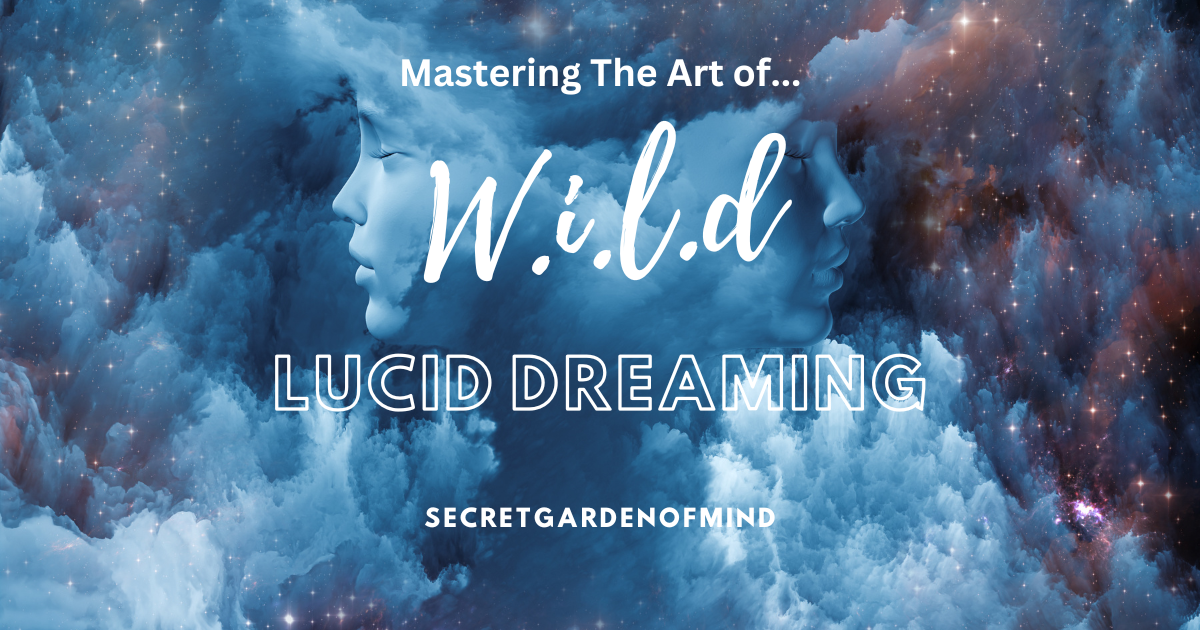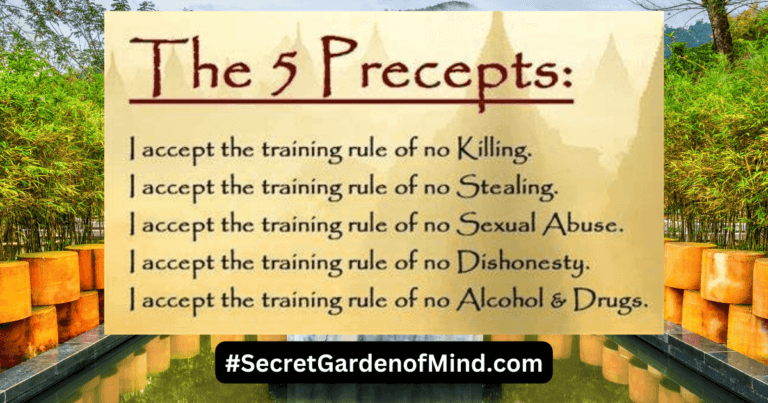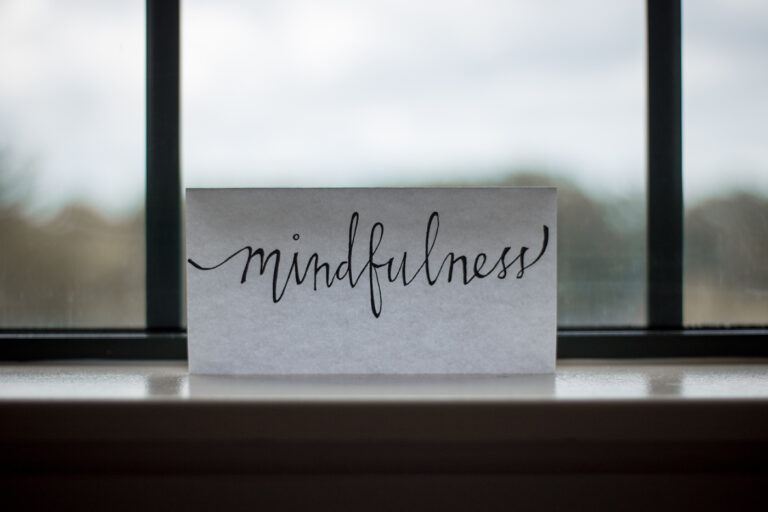Mastering the Art of Wake-Induced Lucid Dreaming: Tips and Tricks

Practicing Wake-Induced Lucid Dreaming is an often recommended exercise for those looking to induce Lucid Dreams. It differs from the usual induction where you are dreaming and you suddenly become aware of your dream state, with the WILD technique this is kind of forced to happen from the moment you begin to fall asleep.
In theory, this means that you are Lucid Dreaming right from the start. There is no part where you fall asleep and you might Lucid Dream – the intention is set as soon as you close your eyes.
Many find this technique to be an effective strategy to Enter the Lucid Dreaming World but how about this?
In today’s post, we shall explore the WILD technique and how you can practice this for yourself as a new method to induce Lucid Dreaming experiences. We shall also look at if this really works and what other options are there to consider.
So, let’s begin…
Mastering the Art of Wake-Induced Lucid Dreaming: Tips and Tricks for a Mind-Blowing Experience

Wake-Induced Lucid Dreaming (WILD) is a technique that allows individuals to enter a dream state directly from a waking state, without losing consciousness. It is considered one of the most advanced and powerful methods of lucid dreaming, offering a mind-blowing experience that can be both exhilarating and transformative.
Mastering WILD can open up a world of possibilities within the dream realm, allowing individuals to explore their subconscious, overcome fears, and tap into their creativity.
In this article, we will delve into the intricacies of Wake Induced Lucid Dreaming, and its benefits, and provide tips and techniques for successfully inducing lucid dreams through this technique. Now…
What is Wake-Induced Lucid Dreaming?
Wake-induced Lucid Dreaming (WILD) is a technique that involves maintaining awareness while transitioning from wakefulness to the dream state. Unlike other types of lucid dreaming, such as Dream Induced Lucid Dreaming (DILD), where individuals become aware that they are dreaming while already in the dream, WILD allows individuals to consciously enter the dream state from a fully awakened state right from the get-go.
The science behind WILD lies in the concept of maintaining awareness during the transition from wakefulness to sleep.
As the body falls asleep, the mind remains awake, creating a state of consciousness within the dream. This state allows individuals to have full control over their dreams, enabling them to shape their dream environment and experiences.
But does this really work?
The Benefits of Lucid Dreaming
Lucid Dreaming, whether it happens through the WILD technique or not offers numerous benefits that can enhance various aspects of an individual’s life.
Some of these benefits include;
- Improved problem-solving skills,
- Enhanced creativity,
- Overcoming fears and phobias, and
- Improved sleep quality.
Each of these I will further discuss briefly below;
i.) Improved Problem-Solving Skills:
Lucid dreaming provides a unique opportunity to explore different scenarios and find creative solutions to problems. By practicing problem-solving within the dream state, individuals can enhance their ability to think outside the box and come up with innovative solutions in their waking lives.
ii.) Enhanced Creativity:
Lucid dreaming allows individuals to tap into their subconscious mind, which is a wellspring of creativity. By actively engaging with their dreams and exploring different dreamscapes, individuals can unlock their creative potential and gain inspiration for various artistic endeavors.
iii.) Overcoming Fears and Phobias:
Lucid dreaming provides a safe environment for individuals to confront and overcome their fears and phobias. By becoming aware that they are dreaming, individuals can consciously face their fears within the dream and gradually desensitize themselves to them, leading to personal growth and empowerment.
iv.) Improved Sleep Quality:
Engaging in lucid dreaming practices, such as WILD, can improve overall sleep quality. By actively participating in the dream state, individuals can feel more rested and rejuvenated upon waking. Lucid dreaming can also help individuals overcome sleep disorders, such as insomnia, by providing a sense of control and relaxation before sleep.
Preparing Your Mind and Body for WILD
Before attempting WILD, it is essential to prepare your mind and body for the experience. This involves practicing relaxation techniques, creating a conducive sleep environment, and incorporating mindfulness and meditation into your daily routine.
Importance of Relaxation Techniques:
Relaxation techniques, such as deep breathing exercises, progressive muscle relaxation, and guided imagery, can help calm the mind and body before attempting WILD.
By reducing stress and promoting relaxation, these techniques create an optimal state for lucid dreaming.
Creating a Conducive Sleep Environment:
Creating a sleep environment that is conducive to lucid dreaming is crucial for successful WILD attempts. This includes ensuring a comfortable bed, minimizing external distractions, and maintaining a consistent sleep schedule. Additionally, incorporating elements such as aromatherapy or soothing music can further enhance the dream experience.
Practicing Mindfulness and Meditation:
Mindfulness and meditation practices can help improve focus and awareness, which are essential for WILD.
By incorporating mindfulness into your daily routine, you can train your mind to be more present and attentive, making it easier to maintain awareness during the transition from wakefulness to sleep.
The Importance of Keeping a Dream Journal
Keeping a dream journal is a vital tool for anyone interested in lucid dreaming, including those practicing WILD. A dream journal serves several purposes. These include all the following;
i.) Keeping Track of Dream Patterns
By consistently recording your dreams in a journal, you can identify recurring themes, symbols, and patterns within your dreams. This can provide valuable insights into your subconscious mind and help you recognize when you are dreaming.
ii.) Identifying Dream Signs:
Dream signs are elements within dreams that indicate you are dreaming. By reviewing your dream journal regularly, you can identify common dream signs that occur in your dreams. This awareness can then be used as a reality check to determine if you are dreaming or awake.
iii.) Enhancing Dream Recall:
Keeping a dream journal helps improve dream recall by training your mind to remember dreams upon waking. By writing down your dreams immediately after waking up, you reinforce the importance of remembering your dreams, making it easier to recall them in the future. I have written a couple of dream diary entries if anyone is interested HERE<<
Reality Checks When You’re Dreaming
Reality checks are an essential component of lucid dreaming, as they help individuals determine whether they are dreaming or awake. By regularly performing reality checks throughout the day, individuals can train their minds to question their reality and increase the likelihood of becoming lucid in their dreams.
Common Reality Checks:
There are several common reality checks that individuals can perform to determine if they are dreaming. These include looking at a clock or digital device and then looking away and back again to see if the time changes, attempting to push a finger through the palm of the opposite hand, or trying to levitate off the ground.
Importance of Performing Reality Checks Regularly:
Consistently performing reality checks throughout the day helps train the mind to question reality, making it more likely to carry over into the dream state. By making reality checks a habit, individuals increase their chances of becoming lucid in their dreams.
How To Incorporate Reality Checks Into Your Daily Routine:
To incorporate reality checks into your daily routine, set reminders on your phone or use triggers throughout the day, such as passing through a doorway or seeing a specific object. When these triggers occur, perform a reality check to determine if you are dreaming or awake.
Techniques for Inducing Lucid Dreams
While WILD is a powerful technique for inducing lucid dreams, there are other methods that individuals can explore. These techniques can be used in conjunction with WILD or as standalone methods for inducing lucid dreams.
Some popular techniques include
- the Mnemonic Induction of Lucid Dreams (MILD),
- the Wake Back to Bed (WBTB) technique, and
- the Reality Testing (RT) technique.
WILD Technique Step-by-Step:
The WILD technique involves maintaining awareness while transitioning from wakefulness to sleep. To practice WILD, find a comfortable position and relax your body. Focus on your breath or a specific point of concentration to maintain awareness as your body falls asleep.
As you enter the hypnagogic state, which is the transitional state between wakefulness and sleep, visualize yourself entering a dream environment. With practice, you will be able to enter the dream state while maintaining full awareness.
Other Techniques for Inducing Lucid Dreams:
The Mnemonic Induction of Lucid Dreams (MILD) technique involves setting intentions before sleep and repeating a mantra, such as “I will have a lucid dream tonight,” to increase the likelihood of becoming lucid in your dreams.
The Wake Back to Bed (WBTB) technique involves waking up after a few hours of sleep, staying awake for a short period, and then going back to sleep with the intention of having a lucid dream.
The Reality Testing (RT) technique involves regularly performing reality checks throughout the day to increase the chances of becoming lucid in your dreams.
Tips for Successful WILD Attempts:
To increase your chances of success with WILD, it is important to practice consistently and be patient. WILD can be a challenging technique to master, as it requires a delicate balance between maintaining awareness and allowing the body to fall asleep.
It is also helpful to practice relaxation techniques, such as deep breathing or progressive muscle relaxation, before attempting WILD.
Additionally, creating a conducive sleep environment and incorporating mindfulness and meditation into your daily routine can enhance your chances of success.
Common Obstacles in Lucid Dreaming
While lucid dreaming can be an incredible experience, there are common obstacles that individuals may encounter along the way. These obstacles include the following 3 things;
i.) Sleep Paralysis:
Sleep paralysis is a temporary inability to move or speak that occurs when transitioning between sleep and wakefulness. It can be a frightening experience, but it is important to remember that it is a natural part of the sleep cycle. To overcome sleep paralysis, focus on remaining calm and remind yourself that it is a temporary state.
Try to relax your body and focus on your breath until the episode passes.
ii.) False Awakenings:
False awakenings occur when individuals believe they have woken up from a dream, only to realize they are still dreaming. To overcome false awakenings, it is important to perform reality checks upon waking to determine if you are truly awake or still in a dream. By incorporating reality checks into your daily routine, you can increase your chances of recognizing false awakenings and becoming lucid in your dreams.
iii.) Difficulty Maintaining Lucidity:
Maintaining lucidity throughout a dream can be challenging, as the excitement of realizing you are dreaming can often cause individuals to wake up. To overcome this obstacle, it is important to practice stabilizing techniques, such as rubbing your hands together or spinning in the dream.
These techniques help ground you in the dream and prevent premature awakening.
Enhancing Your Lucid Dreaming Experience with Visualization and Intention Setting
Visualization and intention setting are powerful tools for enhancing the lucid dreaming experience. By setting intentions before sleep and incorporating visualization techniques, individuals can shape their dreams and have more meaningful and transformative experiences.
Importance of Setting Intentions Before Sleep:
Setting intentions before sleep involves consciously deciding what you want to experience or achieve in your dreams. By setting clear intentions, you provide your subconscious mind with a roadmap for the dream experience, increasing the likelihood of having a lucid dream and achieving your desired outcomes.
Visualization Techniques for enhancing lucid dreams:
Visualization involves mentally creating images or scenarios in your mind’s eye. By visualizing specific dream scenarios or environments before sleep, you can increase the likelihood of experiencing them in your dreams. For example, if you want to fly in your dream, visualize yourself soaring through the sky with ease and joy.
Tips for incorporating visualization and intention setting into your lucid dreaming practice:
To incorporate visualization and intention setting into your lucid dreaming practice, set aside time before bed to visualize your desired dream experiences. Use all of your senses to make the visualization as vivid as possible.
Additionally, write down your intentions in your dream journal to reinforce them and review them regularly.
Exploring the Possibilities of Lucid Dreaming: Flying, Teleportation, and More

One of the most exciting aspects of lucid dreaming is the ability to explore different possibilities within the dream realm. Common lucid dreaming experiences include flying, teleportation, time travel, and meeting with deceased loved ones.
By harnessing the power of lucid dreaming, individuals can tap into their imagination and experience things that may not be possible in the waking world.
Tips for Exploring Different Possibilities in Lucid Dreams:
To explore different possibilities in lucid dreams, it is important to have a clear intention and visualize the desired experience before sleep. During the dream, remind yourself that you are in control and can shape the dream environment and experiences. Practice stabilizing techniques, such as rubbing your hands together or focusing on your breath, to maintain lucidity and prolong the dream experience.
Importance of Respecting Your Subconscious and Others in Your Dreams:
While lucid dreaming allows individuals to have control over their dreams, it is important to respect the subconscious mind and others within the dream. Lucid dreaming is a powerful tool for self-exploration and personal growth, but it is essential to approach it with a sense of responsibility and respect.
The Ethics of Lucid Dreaming: Respecting Your Subconscious and Others in Your Dreams
Ethical lucid dreaming involves respecting your subconscious mind and others within your dreams. It is important to approach lucid dreaming with a sense of responsibility and mindfulness, as it can have a profound impact on your mental and emotional well-being.
Importance of ethical lucid dreaming: Ethical lucid dreaming ensures that individuals engage with their dreams in a responsible and respectful manner. By approaching lucid dreaming with ethics in mind, individuals can avoid potential negative consequences and foster a positive relationship with their subconscious mind.
Respecting Your Subconscious and Others in Your Dreams:
Respecting your subconscious involves approaching your dreams with curiosity and openness, rather than trying to control or manipulate them. It is important to listen to the messages and symbols that arise within your dreams and use them as tools for self-exploration and personal growth.
Additionally, respecting others within your dreams involves treating dream characters with kindness and empathy, recognizing that they are manifestations of your subconscious mind.
Tips for Practicing Ethical Lucid Dreaming:
To practice ethical lucid dreaming, approach your dreams with a sense of curiosity and respect. Take the time to reflect on the messages and symbols that arise within your dreams and use them as tools for self-exploration. Treat dream characters with kindness and empathy, recognizing that they are part of your subconscious mind.
Additionally, avoid using lucid dreaming for harmful or unethical purposes, such as manipulating others or engaging in violent behavior.
In Conclusion
Mastering Wake-Induced Lucid Dreaming (WILD) can provide a mind-blowing experience that opens up a world of possibilities within the dream realm. By practicing relaxation techniques, creating a conducive sleep environment, and incorporating mindfulness and meditation into your daily routine, you can prepare your mind and body for successful WILD attempts.
Keeping a dream journal, performing reality checks regularly, and setting intentions before sleep are essential tools for enhancing your lucid dreaming practice.
By exploring different techniques for inducing lucid dreams and overcoming common obstacles, you can increase your chances of having transformative and meaningful experiences within the dream state.
Just remember to approach lucid dreaming with ethics in mind, respecting your subconscious and others within your dreams. Start practicing WILD today and prepare yourself for a mind-blowing journey into the depths of your subconscious mind.
Related Links:
- What Is The Difference Between Astral Projection and Lucid Dreaming?
- How To Keep Yourself In a Lucid Dream – 5+ Ideas
- Exploring Lucid Dreaming Masks and How They Work?
- Does Milk Help Lucid Dreaming? Strange Fact or Myth?
- Understanding Lucid Dreams: A Guide to Lucid Dream Analysis
- Sleep Cycles and Lucid Dreaming: How Does One Affect The Other?
- Can You Train Your Brain To Lucid Dream? and Other FAQs


amazon bean products bean products accent pillows bean products bean bags bean products bed pillows bean products bolster bean products chicago bean products coupon code bean products decorative accent pillows bean products shredded foam bean products usa bean products yoga bean products zafu benefits of meditation for adhd best type of meditation for adhd buddhist meditation for adhd Dream Diaries Dream Master energy healing how to lucid dream Law of Attraction Laxman innertainment Light and Sound Machine Light and Sound Meditation Mind Machine lucid dream herbs Manifestation meditation meditation alzheimer meditation alzheimer prevention meditation alzheimers meditation classes adhd meditation cure adhd meditation dementia meditation for adhd adults meditation for adults with adhd meditation for memory loss meditation memory meditation memory loss Mindplace Procyon mr bean new products pre dementia reiki dementia remote viewing amplifier remote viewing baby monitor remote viewing books pdf remote viewing experiments





